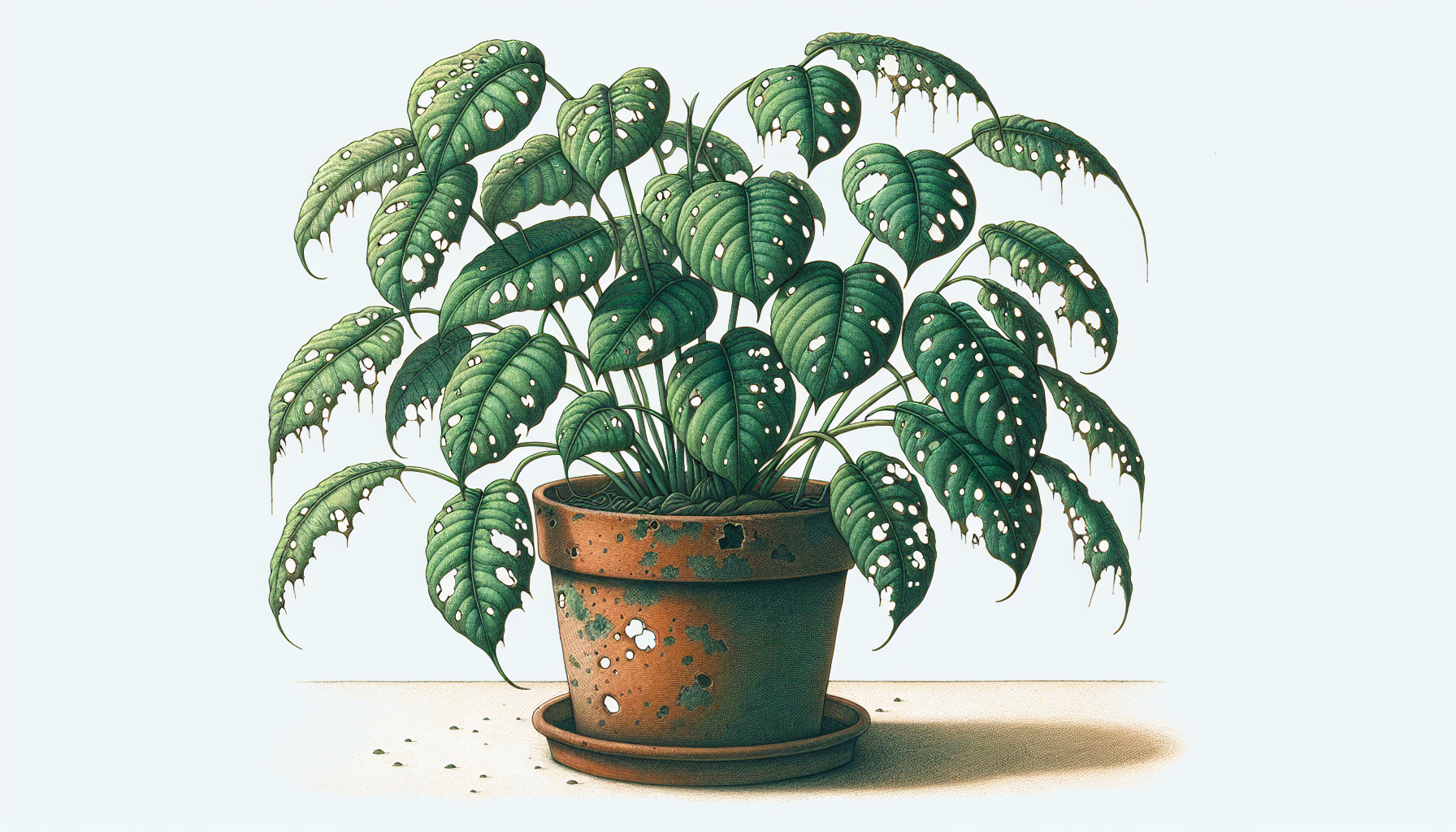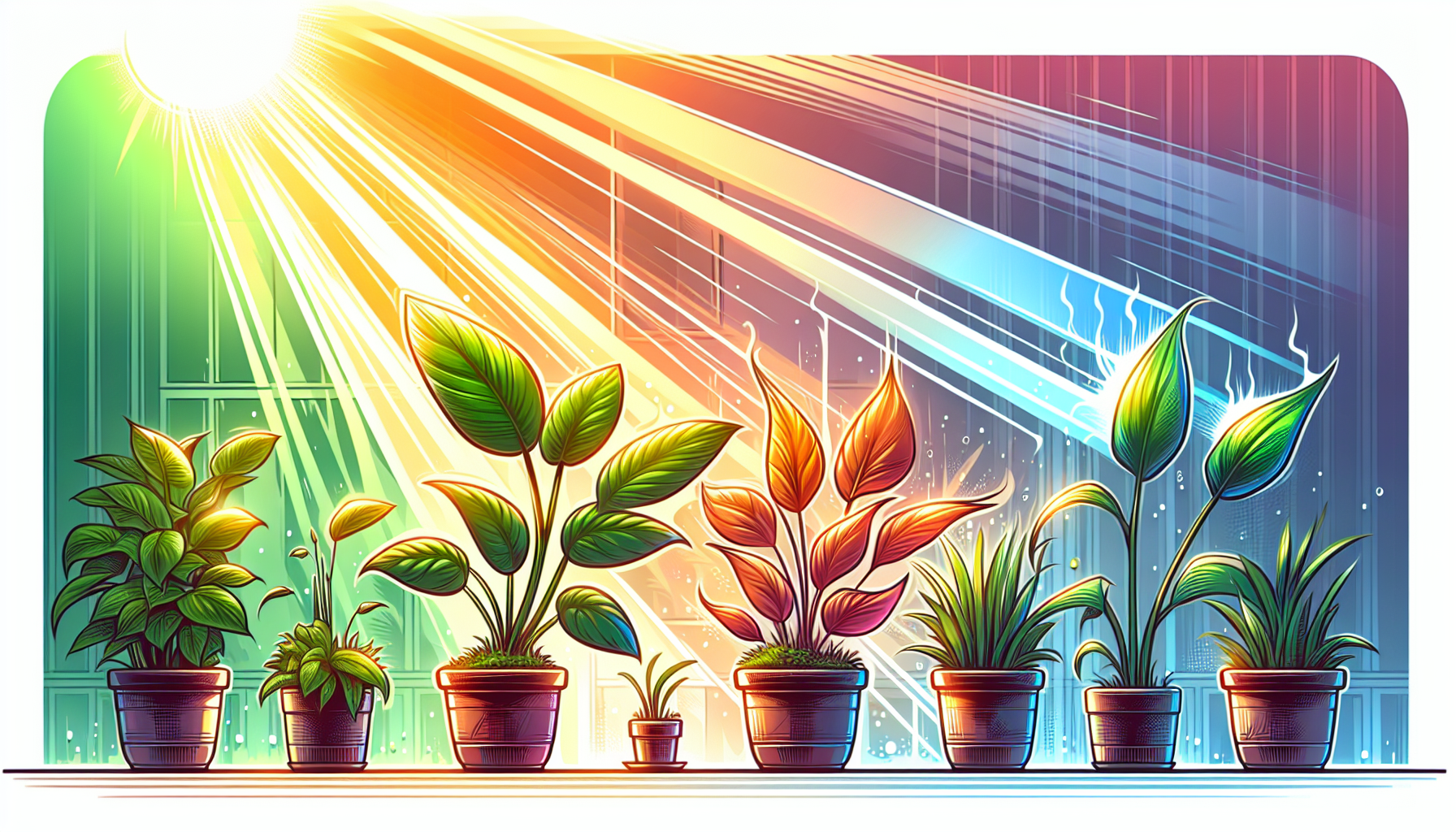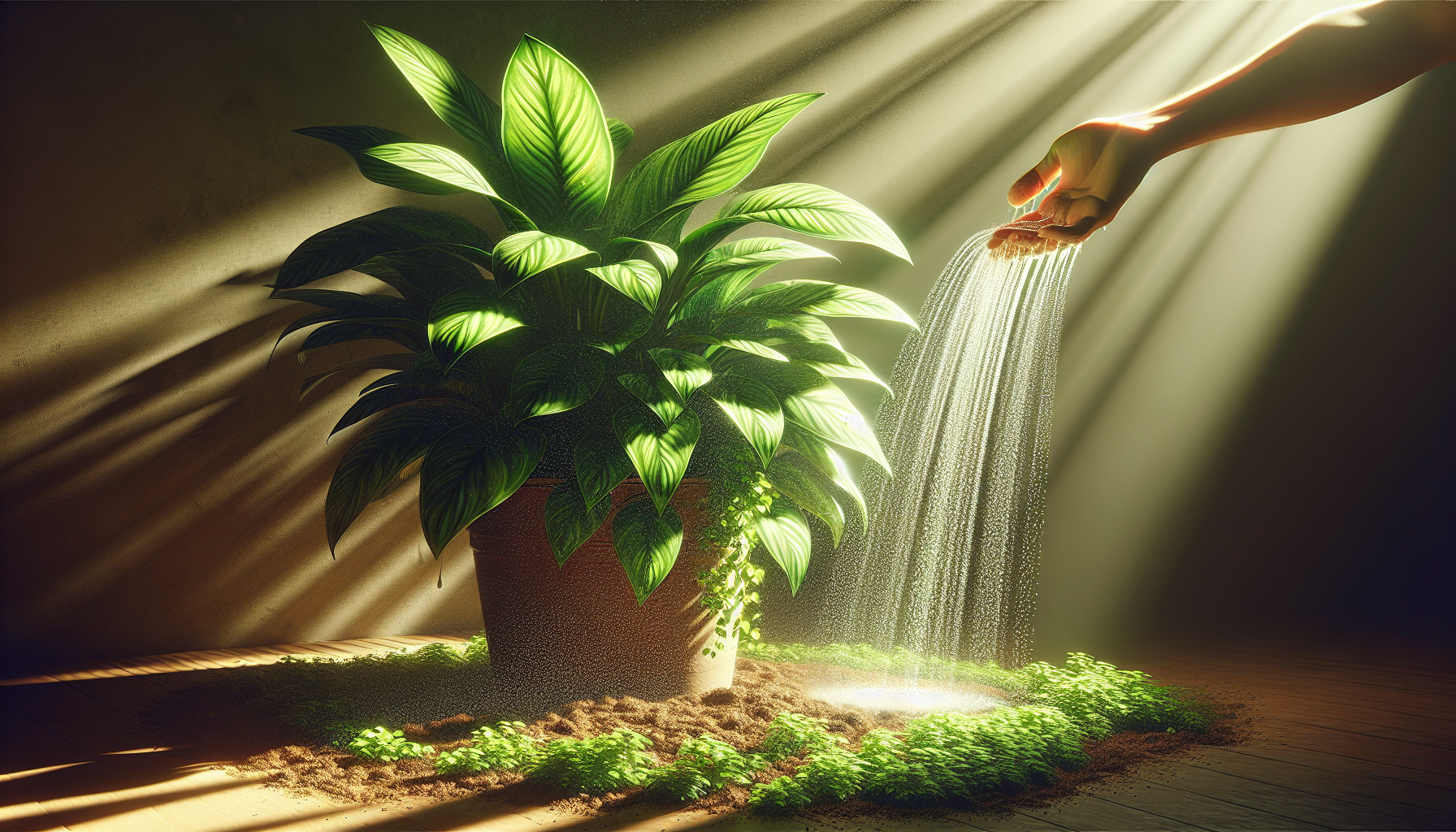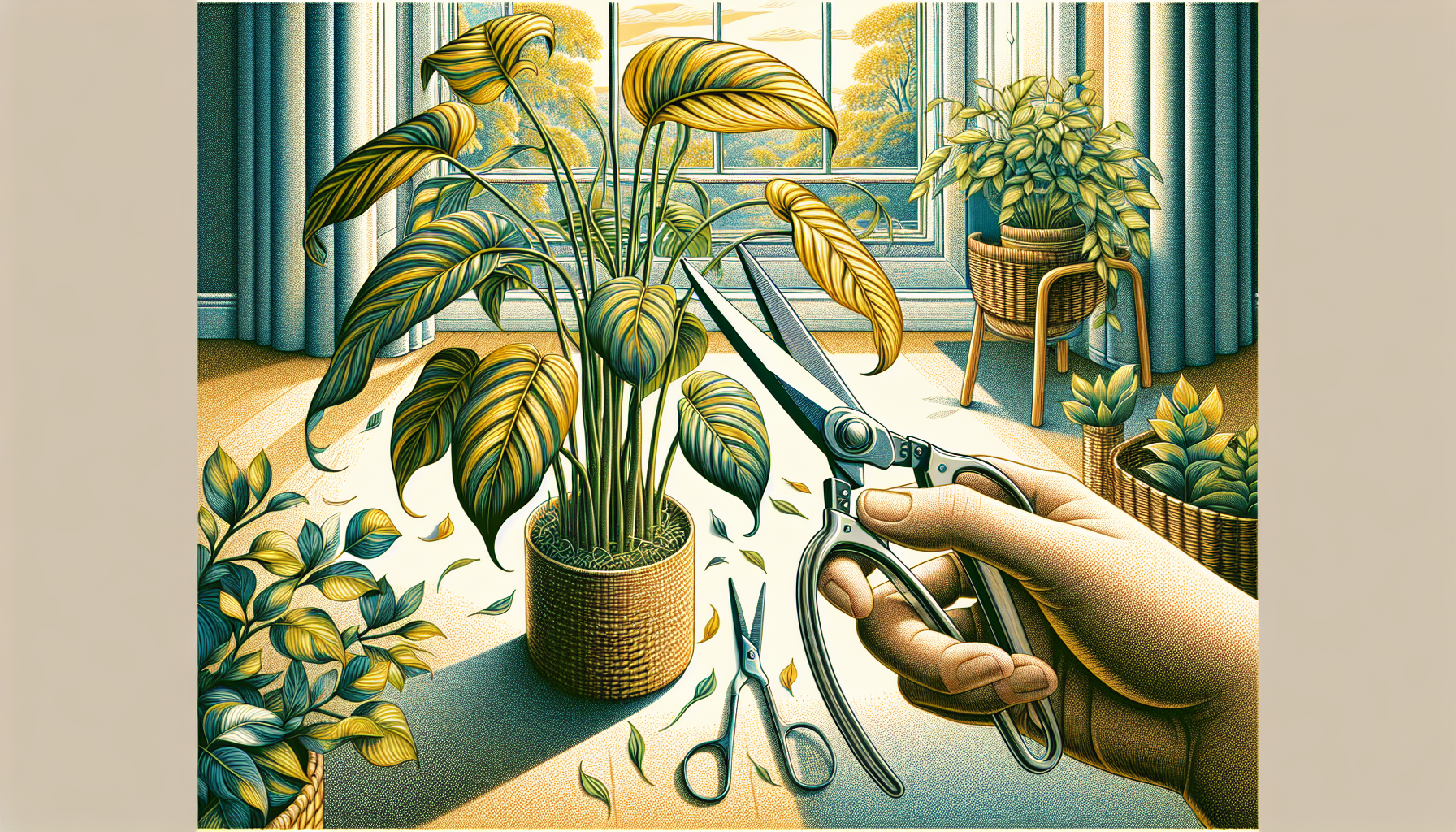Troubleshooting Holes in Plant Leaves Indoor: Proven Solutions for Healthy Foliage
If you're puzzled by holes in your indoor plant leaves, you're likely looking for a swift diagnosis and remedy. This blog will discuss, exploring common offenders like pests and diseases, and environmental factors that can wreak havoc on your greenery. We'll help you get to the root of the problem with holes in plant leaves and guide you towards restoring the health of your plants.
Key Takeaways
-
Indoor plant leaf holes can be caused by pests like spider mites and caterpillars, or by fungal diseases—preventive measures and early treatment are critical for plant health.
-
The indoor environment, including factors like humidity, light, and temperature, plays a key role in plant health and can influence the occurrence of leaf holes.
-
Proper care including appropriate watering techniques, effective pest control, and the use of fertilizers are essential for preventing leaf damage and promoting recovery and new growth in damaged plants.
Indoor Plant Culprits: Identifying the Cause of Leaf Holes

First things first – who's the baddie causing those holes? Let's play detective and identify the usual suspects. Spider mites, caterpillars, and fungal diseases are often the main culprits behind holes in indoor plant foliage. But how do you tell them apart? Well, each pests leaves a distinct sign on your beloved plant, and recognizing these can help you catch the problem early and treat it effectively.
Now, let's take a closer look at each of these culprits. We'll delve into the world of tiny spider mites, the ravenous caterpillars, and the stealthy fungal diseases. By understanding these pests and diseases, you'll be better equipped to spot the signs early and jump into action to save your indoor greenery.
Spider Mites
Picture this: you're watering your plants one morning, and suddenly you notice a strange web-like structure on one of your plants. Upon closer inspection, you spot tiny brown or yellow spots on the leaves. My friend, you might be dealing with a spider mite infestation! These tiny arachnids are challenging to detect as they're often too small to spot with the naked eye. However, their presence becomes clear when you see that reddish film, webbing, or leaf damage on your plants.
So, how do you wage war against these pesky invaders? Spider mites thrive in dry conditions, so keeping your plants moist and maintaining higher humidity levels can help prevent and manage infestations. If you confirm their presence by shaking your plant's leaves over a piece of paper and seeing tiny pepper-like specks, it's time to bring out the big guns. Remove the plant, wash it thoroughly, and employ measures like spraying with water or applying insecticidal soaps. Make sure to leave the plant away from any natural or grow lights. Insecticidal soaps can cause leaf burn, on occasion.
Non-chemical remedies like using natural mixtures with peppermint, garlic, or rosemary and water, or a gentle dish soap dilution can also be effective. Remember to keep your plant environment clean and quarantine new plants to prevent outbreaks.
Trying to get rid of other houseplant pests? Read for more tips
Caterpillars
You've probably seen them in your garden munching away at your plants, but caterpillars can also find their way to your indoor plants and cause havoc. These hungry little critters are the larvae of moths and butterflies that feed on various parts of plants, including:
-
leaves
-
stems
-
roots
-
buds
-
flowers
-
fruits
They're not picky eaters, and they leave tell-tale signs of their feast – they eat holes, and sometimes even “windows” in the leaves where they've burrowed inside.
Caterpillars and Japanese beetles might be cute, but they're no friends to your indoor plants. To manage them, you can:
-
Use biological insecticides like Btk (Bacillus thuringiensis kurstaki)
-
Resort to hand-picking them off your plants and submerging them in soapy water
-
For severe infestations, spot treatments with insect killers can be effective
If you're wondering how this can happen to indoor plants, it's most often from being outside. It's important to thoroughly inspect any plants that have been brought and spent some time outside. Or even new plants. Lots of garden centers keep indoor plants outside, and there could be a pesky caterpillar hiding in the buds or under the leaves.
Just remember, early detection and intervention are key to preventing significant damage and ensuring your entire plant remains lush and healthy.
Fungal Diseases and Root Rot
Last on our list of culprits are the silent invaders – fungal diseases, often leading to fungal infection. Unseen but equally harmful, fungi like Anthracnose, Cercospora, and shot hole disease are known to cause holes in plant leaves. These diseases can be particularly tricky as the symptoms often appear when the infection is already advanced. For instance, shot hole disease creates pellet-sized holes in leaves, while the Cercospora fungus causes brown spots that can lead to hole formation.
But don’t lose heart! Preventing fungal disease is entirely possible with a few simple precautions. You can keep these troubles at bay by allowing proper space for each plant, ensuring good air circulation around your plants, and keeping the leaves dry, particularly overnight. Remember, prevention is always better than cure, especially when it comes to fungal diseases in your indoor plants.
Environmental Factors: How Indoor Conditions Influence Leaf Damage

Having discussed the common culprits behind leaf holes, let's now shift our attention to another key factor – the indoor environment. Yes, the conditions within your home can significantly influence leaf damage in indoor plants. Factors like humidity, light, and temperature play a crucial role in your plant's overall health and can help prevent and treat leaf holes.
So, how exactly do these conditions impact your plants, and how can you optimize them for healthier foliage? Let's dive into each factor and explore ways to create an ideal indoor environment for your plants. We'll discuss how to regulate humidity, provide adequate light, and maintain the right temperature – all essential elements in fostering a thriving indoor garden.
Humidity
Imagine being in a dry, arid climate when you’re used to a humid, tropical environment. You’d feel parched and uncomfortable, right? Your indoor plants feel the same way! Plants like Monstera, native to the rainforests, thrive in high humidity conditions, typically around 50% or higher. However, most home environments can’t naturally offer this level of humidity, and that’s where we need to step in.
In dry environments, plants may transpire more water through their stomata, which can result in damage such as brown leaf edges or brown leaf tips. So, how can you increase humidity for your indoor plants? Here are some methods:
-
Group plants together
-
Use pebble trays
-
Use humidifiers
-
Create a terrarium to create controlled high-humidity conditions
Remember, a plant in a high-humidity environment is a happy plant, less prone to pests and leaf damage.
Light
Just like us, plants need light to thrive. But not just any light – the right amount and quality of light. Indoor plant leaves can be affected by the availability of light. Both inadequate and excessive light can contribute to leaf damage or the formation of holes. If a mature plant is producing bigger leaves with holes, moving it closer to a brighter light source can promote healthier growth.
Light levels are crucial for the growth and health of plant leaves, directly influencing their development. But remember, while direct light, such as direct sun, is crucial, it’s all about balance. Too little light, and your plant might struggle to perform photosynthesis. Too much light, and it can lead to leaf burn. So, adjust the light conditions according to your specific plant’s needs for a happy, healthy indoor plant.
Understanding lighting for houseplants
Temperature
Keeping up with the temperature preferences of your indoor plants can be a bit like Goldilocks trying to find the bed that's “just right”. Some like it hot, some prefer it cool, but most indoor plants, like the Monstera, flourish in temperatures between 65°F and 85°F (18°C to 29°C). This range promotes proper growth and the development of distinctive leaf patterns.
Rapid fluctuations or exposure to extreme heat or cold can cause temperature stress, resulting in wilting, yellowing, or blackened leaves. To prevent temperature stress on indoor plants, follow these tips:
-
Keep a consistent temperature range
-
Avoid drafts from heating or cooling appliances
-
Provide cooler temperatures at night to aid in the natural recovery process and contribute to growth
By following these guidelines, you can help your indoor plants thrive and eventually be ready to plant outdoors.
Prevention and Treatment: Keeping Your Potted Plants Healthy

So, we’ve identified the culprits behind leaf holes and understood how environmental factors can contribute to leaf damage, including affected leaves. Now, it’s time to discuss how to prevent these issues and keep your indoor plants healthy. Prevention and treatment involve proper watering techniques, pest control methods, and appropriate care practices.
Let’s delve into each of these aspects, providing you with practical and easy-to-follow guidelines. From watering to pest control to maintaining the right conditions, we’ll cover all you need to know to ensure your indoor plants stay lush, vibrant, and hole-free.
Watering Techniques
Water – it’s a simple substance, and yet, it plays such a crucial role in plant health. Watering your plants seems straightforward enough, but did you know that how you water your indoor plants can make a significant difference? Overwatering or underwatering can lead to a host of plant problems, from root rot to pest infestations.
So, what are the right watering techniques? Here are some tips to follow:
-
Assess the moisture level of the soil by inserting a finger about an inch deep to determine when to water.
-
Water your plant until the soil is thoroughly soaked and begins to drain from the bottom - this ensures that the roots receive adequate moisture.
-
Always use room-temperature tap water to prevent leaf and root damage.
-
Water at the base, not the leaves, to avoid fungal diseases.
-
Ensure your pots and soil have good drainage to avoid root rot and pest issues.
Remember, proper watering is a simple yet effective way to maintain healthy indoor plants.
Pest Control Methods
Keeping your indoor plants free of pests can sometimes feel like a never-ending battle. Effective pest control also helps in preventing bacterial infection, which can cause dark brown, slightly sunken leaf spots. But with the right strategies, you can keep these pesky invaders at bay. Effective pest control requires regular inspection of plants, isolating new plants to detect pests early, and keeping the plant environment clean.
Non-chemical pest management methods include washing plants, physically removing pests, pruning affected areas, and using yellow or blue sticky traps to detect flying insects. For more severe infestations, chemical pesticides with active ingredients like pyrethrins, potassium fatty acids, plant oil extracts, neem oil, Bacillus thuringiensis, and imidacloprid can be used, including insecticidal soap. But remember, some of these can be toxic to beneficial insects like bees, so use them responsibly.
With the right pest control methods, you can ensure your indoor plants stay healthy and vibrant.
Appropriate Care Practices
All plants are unique, and understanding their specific needs is crucial for their health and growth, especially when dealing with issues like brown leaves. Providing the appropriate care conditions, such as the right amount of light, water, and nutrients, is essential to facilitate plant health and encourage entire leaves to split and grow without holes. Observing a plant’s leaves can be a helpful indicator of its overall well-being.
Variegated Monstera plants, for instance, need:
-
Bright, indirect light which is more intense than what their non-variegated counterparts require
-
Sterilized pruning tools to trim damaged leaves and avoid the spread of diseases
-
Fertilizers rich in nitrogen to promote the growth of new foliage, especially for indoor plants recovering from leaf damage.
Remember, the right care practices can make a world of difference in maintaining the health and vibrancy of your indoor plants.
Recognizing Natural Leaf Features: When Holes Are Not a Problem
Now, here's a plot twist – not all holes in plant leaves indicate a problem! Yes, some indoor plants naturally have holes in their leaves as part of their growth pattern. This phenomenon, known as leaf fenestration, occurs in several indoor plants like Monstera deliciosa, Monstera Adansonii or Cebu Blue Pothos. As these plants mature, they develop holes and splits in their leaves, transitioning from a heart-shaped to a more perforated leaf structure.
These irregular holes may be adaptations to environmental factors, allowing the plants to create holes to withstand strong winds, enable better water flow to the roots, and capture sunlight more effectively in dense forest conditions. So, the next time you see holes in your Monstera's leaves, take a moment to appreciate its natural beauty and uniqueness. After all, not all holes signify a problem, and sometimes, they're just a part of your plant's charm!
Reviving Damaged Leaves: Steps to Encourage New Growth

So, what if you’ve already spotted some leaf damage? Don’t worry! There’s always a way to revive those damaged leaves and encourage new growth. By following a few simple steps, such as pruning, providing proper nutrients, and ensuring adequate humidity and light, you can help your plants recover and flourish again.
Let’s delve into each of these steps and understand how they can help in the recovery and rejuvenation of your indoor plants. With the right care and a bit of patience, you’ll soon see your plants bouncing back to health, growing new, vibrant leaves that’ll brighten up your indoor garden.
Pruning Damaged Leaves
Pruning may seem like a drastic measure, but it’s often the best way to help your plants recover from leaf damage. By removing damaged leaves, you’re not only preventing the spread of disease but also helping your plant focus its energy on growing healthy leaves. In plants like Monstera, trimming older leaves can stimulate the development of larger, more fenestrated leaves.
But remember, pruning should be done with care. Use clean, sharp scissors or pruning shears to make a clean cut on the damaged leaf, avoiding any healthy tissue to prevent stress to the plant. Dispose of pruned leaves away from the plant to reduce the risk of disease transmission.
After pruning, monitor the plant for new growth and adjust care practices as needed to promote healthy development.
Providing Proper Nutrients
Just like we need a balanced diet to stay healthy, plants too need a mix of nutrients for their growth and well-being. When recovering from leaf damage, providing your plants with the right nutrients is key to encouraging new growth. Fertilizers rich in nitrogen, for instance, are essential in promoting the growth of new foliage, especially for indoor plants recovering from leaf damage.
Remember, each plant has its unique nutritional needs, so do your research or consult with a plant care expert to understand what nutrients your specific plant needs. Regularly feeding your plants with the right nutrients can significantly enhance their health and vitality, helping them bounce back from any leaf damage.
Ensuring Adequate Humidity and Light
Finally, let’s not forget the importance of providing your plants with adequate humidity and light. These two factors are vital for the healing of damaged leaves and promoting healthy plant growth. Reflective, light-colored surfaces inside a home or office can improve the intensity of light available to indoor plants, supporting their recovery.
Similarly, maintaining a humid environment is beneficial for the healing of damaged leaves. You can use a humidifier or pebble trays filled with water to raise the humidity in the vicinity of your indoor plants. By ensuring your plants get the right amount of light and humidity, you’re setting them up for a successful recovery and healthy growth.
Summary
Our journey through the world of indoor plant care has been a fascinating one. We’ve delved into the causes of leaf holes, explored how environmental factors can influence leaf damage, and learned how to prevent and treat these issues. We’ve discovered that not all holes are a problem, and sometimes, they’re just a part of a plant’s natural beauty. We’ve also discussed how to revive damaged leaves and encourage new growth.
Remember, every plant is unique, and understanding their specific needs is the key to successful plant care. With the right care practices, you can prevent leaf holes, treat any issues that arise, and ensure your indoor plants stay vibrant and healthy. So keep learning, keep growing, and enjoy the fulfilling journey of indoor gardening!
Frequently Asked Questions
How can I prevent leaf holes in my indoor plants?
To prevent leaf holes in your indoor plants, make sure to provide the right care conditions, maintain proper humidity and light levels, water appropriately, and use effective pest control methods. Keep your plants healthy and thriving!
Are all leaf holes a sign of a problem?
No, not all leaf holes are a sign of a problem. Some plants, like Monstera, naturally develop holes in their leaves as part of their growth.
How can I revive a plant with damaged leaves?
To revive a plant with damaged leaves, simply prune the damaged parts, provide proper nutrients, and ensure it gets enough humidity and light.
What are some common pests that cause leaf holes?
Spider mites, caterpillars, and certain fungal diseases are common pests that cause leaf holes. Watch out for them to protect your plants!
How can I increase the humidity for my indoor plants?
To increase the humidity for your indoor plants, you can group them together, use pebble trays or humidifiers, or create a terrarium for high-humidity plants. Try these tips to improve the environment for your plants!
Check out these links for plant related products you'll love!
Monstrella trellis, perfect for long vining plants
Zella trellis, extendable cedar trellis made to grow with your plants
Monstrella wall mounts, great for creating a living wall
